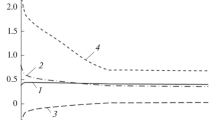A new approach to the determination of the ablation properties of a heat-shield carbon material on the basis of analysis of the results of an experimental investigation of its ablation in the jet of an electric-arc plant in the nonstationary regime has been formulated. Original data on the kinetic constants of oxidation of carbon by atomic oxygen have been obtained.
Similar content being viewed by others
References
V. V. Gorskii, S. L. Zorotarev, and A. A. Olenicheva, Computational and experimental investigations into the mass loss of a carbon material in the sublimation regime of its thermochemical destruction, J. Eng. Phys. Thermophys., 88, No. 1, 163–167 (2015).
N. A. Anfimov, G. A. Beda, I. P. Danilenko, S. L. Zorotarev, and V. A. Fadeev, Gasdynamic electric-arc plants of the TsNIImash. Diagrams and methods of testing, Kosm. Raketostr., No. 2, 33–46 (1994).
V. V. Gorskii and Yu. V. Polezhaev, Combustion of graphite in high-temperature oxidation gas flows, in: Yu. V. Polezhaev (Ed.), Laws of Combustion [in Russian], UNPTs "Énergomash," Moscow (2006), pp. 303–324.
V. V. Gorskii, D. A. Zabarko, and A. A. Olenicheva, Investigation of the process of ablation of a carbon material within the framework of the complete thermochemical model of its destruction for the case of an equilibrium chemical reaction in the boundary layer, Teplofiz. Vys. Temp., 50, No. 2, 307–313 (2012).
Yu. V. Polezhaev and F. B. Yurevich, Thermal Protection [in Russian], Énergiya, Moscow (1976).
V. V. Gorskii and P. Ya. Nosatenko, Mathematical Simulation of the Processes of Heat and Mass Exchange in the Aerothermochemical Destruction of Heat-Shield Composite Materials Based on Silicon [in Russian], Nauchnyi Mir, Moscow (2008).
V. V. Gorskii, Theoretical Bases of Calculations of Ablation Thermal Protection [in Russian], Nauchnyi Mir, Moscow (2015).
D. Hearst and G. Pound, Evaporation and Condensation [Russian translation], Metallurgiya, Moscow (1966).
Yu. V. Polezhaev, Sublimation, in: Physical Encyclopedic Dictionary [in Russian], Sovetskaya Éntsiklopediya, Moscow (1966), p. 101.
N. A. Anfimov, Combustion of graphite in an air flow at high temperatures, Izv. Akad. Nauk SSSR, Mekh. Mashinostr., No. 5, 3–11 (1965).
A. S. Predvoditelev, E. V. Stupochenko, and E. V. Samuilov, Tables of the thermodynamic functions of air for temperatures from 200 to 6000 K and pressures from 0.00001 to 100 atm, in: A. S. Predvoditelev (Ed.), Tables of Thermodynamic Functions of Air [in Russian], Vych. Tsentr Akad. Nauk SSSR, Moscow (1962).
S. M. Scala and L. M. Gilbert, Ablation of graphite at hypersonic velocities, Raketn. Tekh. Kosmonavt., No. 9, 87–100 (1965).
V. P. Glushko, L. V. Gurvich, and G. A. Bergman (Eds.), Thermodynamic Properties of Individual Substances, Reference Edition in 4 vols. [in Russian], Vol. II, Book 2, Nauka, Moscow (1979).
V. I. Boyarintsev and Yu. V. Zvyagin, Investigation of the destruction of carbon–graphite materials at high temperatures, Izv. Akad. Nauk SSSR, Teplofi z. Vys. Temp., 14, No. 5, 1045–1053 (1975).
F. S. Zavelevich, Combustion of graphite in the chemically equilibrium boundary layer, Izv. Akad. Nauk SSSR, Mekh. Zhidk. Gaza, No. 1, 161–167 (1966).
Yu. D. Pchelkin, Methods of calculating the ablation of carbon materials in air and their application, Abstr. Proc. Int. Sci.-Tech. Conf. "Fundamental Problems of High-Velocity Flows," Izd. Dom. TsAGI, Zhukovsky (2004), pp. 56–58.
J. P. Baron and K. K. Bernshtein, Relation between the rate of destruction of a surface and the processes in the gas phase in the oxidation of graphite, Raketn. Tekh. Kosmonavt., 9, No. 8, 189–198 (1971).
J. H. Landell and R. R. Dickey, Graphite ablation at high temperatures, AIAA Paper, 71–418 (1971).
V. V. Gorskii and A. A. Lavrent′eva, Analysis of a number of elements in the mechanism of mass entrainment of carbon material within the framework of the complete thermochemical model of its destruction, J. Eng. Phys. Thermophys., 82, No. 1, 125–132 (2009).
Yu. V. Linnik, Method of Least Squares and Foundations of the Theory of Processing of Observations [in Russian], Fizmatlit, Moscow (1958).
M. Aoki, Introduction to Optimization Methods [Russian translation], Nauka, Moscow (1977).
J. Moore and M. Zlotnik, Combustion of carbon in an air flow, Raketn. Tekh., 1, No. 10, 35–45 (1961).
C. Park, Influence of atomic oxygen on the ablation of graphite, Raketn. Tekh. Kosmonavt., 14, No. 11, 162–164 (1976).
D. E. Rosner and H. D. Allendorf, Comparative oxidation of pyrolytic and isotropic graphite under the action of atomic and molecular oxygen at high temperatures, Raketn. Tekh. Kosmonavt., 6, No. 24, 91–96 (1968).
Author information
Authors and Affiliations
Corresponding author
Additional information
Translated from Inzhenerno-Fizicheskii Zhurnal, Vol. 90, No. 1, pp. 133–141, January–February, 2017.
Rights and permissions
About this article
Cite this article
Gorskii, V.V., Koval′skii, M.G. & Olenicheva, A.A. Determination of the Kinetic Oxidation Constants of Carbon Materials on the Basis of Analysis of Experiments on Their Ablation. J Eng Phys Thermophy 90, 126–133 (2017). https://doi.org/10.1007/s10891-017-1547-4
Received:
Published:
Issue Date:
DOI: https://doi.org/10.1007/s10891-017-1547-4




